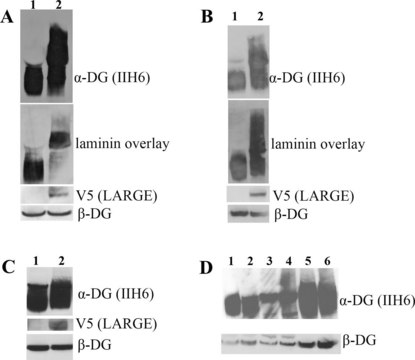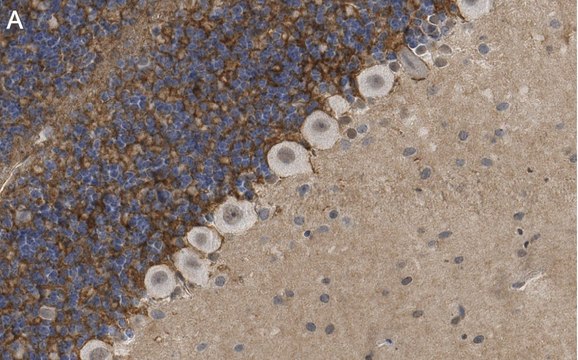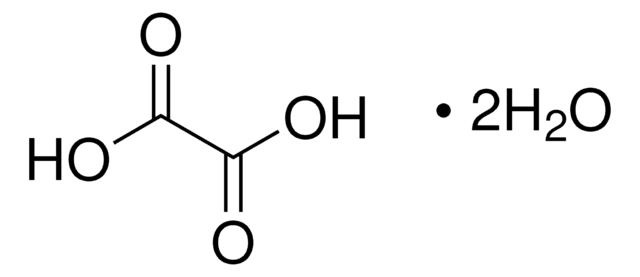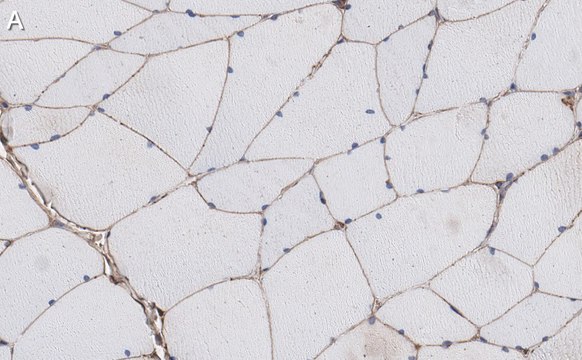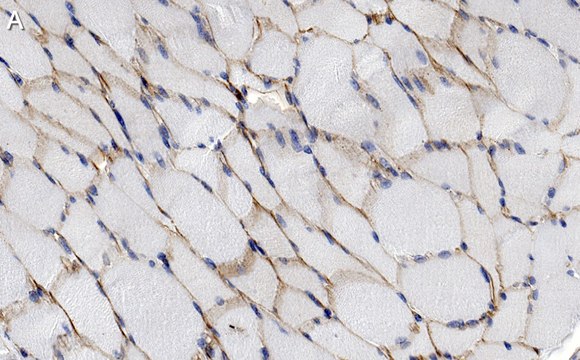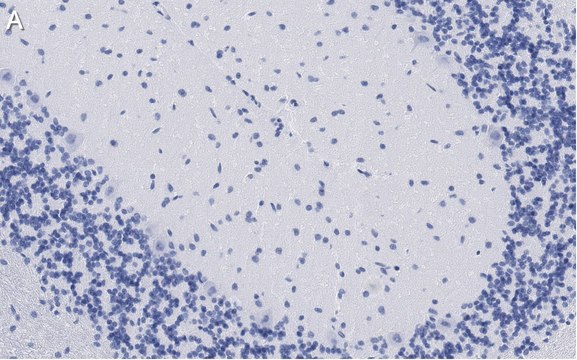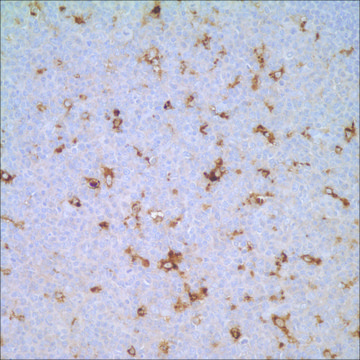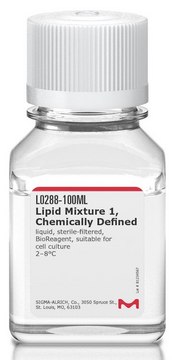Recommended Products
biological source
mouse
Quality Level
conjugate
unconjugated
antibody form
purified antibody
antibody product type
primary antibodies
clone
IIH6 (or IIH6C4), monoclonal
mol wt
calculated mol wt 97.03 kDa
observed mol wt ~43 and 156 kDa
species reactivity
rabbit, human, mouse
species reactivity (predicted by homology)
guinea pig, canine, rat
packaging
antibody small pack of 100 μL
isotype
IgM
UniProt accession no.
shipped in
dry ice
storage temp.
-10 to -25°C
target post-translational modification
unmodified
Gene Information
rabbit ... DAG1(100009278)
General description
Dystroglycan (UniProt: Q28685; also known as Dystrophin-associated glycoprotein 1) is encoded by the DAG1 gene (Gene ID: 100009278) in rabbit. Dystroglycan is a component of the dystrophin glycoprotein complex that serves as an adhesion molecule and links the extracellular matrix to the intracellular actin cytoskeleton. Its expression is reported in the brain, cardiac muscle, skeletal muscle, and placenta. It is synthesized with a signal peptide (aa 1-29) that is subsequently cleaved off to generate the mature protein that is further autolytically cleaved (between 653-654) to produce a-dystroglycan (aa 30-653) and b-dystroglycan (aa 654-895). a-dystroglycan is an extracellular peripheral glycoprotein that binds to several extracellular matrix and synaptic proteins such as laminin-2 and 5, agrin, neurexin, and pikachurin. It is heavily O-glycosylated, which comprises of up to two thirds of its mass and the carbohydrate composition differs depending on tissue type. It is reported that its O-mannosyl glycosylation is required for its ligand- binding functions. b-dystroglycan is a single-pass type 1 transmembrane protein that plays important roles in connecting the extracellular matrix to the cytoskeleton and serves as a cell adhesion receptor in both muscle and non-muscle tissues. In the cell, b-dystroglycan binds to dystrophin that is linked to actin cytoskeleton. Hence, a/b dystroglycans act as a molecular axis connecting extracellular matrix with the cytoskeleton across the plasma membrane. Defects in O-mannosyl glycan have been linked to various congenital muscular dystrophies caused by aberrant a-dystroglycan glycosylation. (Ref.: Kanagawa, M., et al. (2010). J. Biol. Chem. 285(41); 31208-31216; Yamada, H., et al. (1994). FEBS Lett. 352(1); 49-53; Ervasti, JM., and Campbell, KP. (1993). J. Cell Biol. 12(4); 809-823; Ibraghimov-Beskrovnaya, O., et al. (1992). Nature. 355(6362); 696-702).
Specificity
Clone IIH6 (IIH6C4) is a mouse monoclonal antibody that detects Dystroglycan (a-Dystroglycan and uncleaved form) in multiple species.
Immunogen
Rabbit skeletal muscle membrane preparation.
Application
Quality Control Testing
Evaluated by Western Blotting in Rabbit skeletal muscle tissue lysate.
Western Blotting Analysis: 1:1,000 of this antibody detected Dystroglycan in Rabbit skeletal muscle tissue lysate.
Tested Applications
Western Blotting Analysis: A representative lot detected Dystroglycan in Western Blotting applications (Azzag, K., et. al. (2020). Skelet Muscle. 10(1):10 ; Bijata, M., et. al. (2015). Front Cell Neurosci. 9:199).
Immunohistochemistry (Paraffin) Analysis: A 1:50 dilution from a representative lot detected Dystroglycan in mouse heart and mouse skeletal muscle tissue sections.
Flow Cytometry Analysis: A representative lot detected Dystroglycan in Flow Cytometry applications (Gerin, I., et. al. (2016). Nat Commun. 7:11534).
Immunofluorescence Analysis: A representative lot detected Dystroglycan in Immunofluorescence applications (Azzag, K., et. al. (2020). Skelet Muscle. 10(1):10).
Inhibition Analysis: A representative lot reduced agrin-induced ERK activation in cardiac cells. (Bassat, E., et. al. (2017). Nature. 547(7662):179-184)
Immunohistochemistry Applications: A representative lot detected -Dystroglycan in Immunohistochemistry applications (Cataldi, M.P., et. al. (2018). Nat Commun. 9(1):3448).
Immunocytochemistry Analysis: A representative lot detected Dystroglycan in Immunocytochemistry applications (Bijata, M., et. al. (2015). Front Cell Neurosci. 9:199).
Note: Actual optimal working dilutions must be determined by end user as specimens, and experimental conditions may vary with the end user
Evaluated by Western Blotting in Rabbit skeletal muscle tissue lysate.
Western Blotting Analysis: 1:1,000 of this antibody detected Dystroglycan in Rabbit skeletal muscle tissue lysate.
Tested Applications
Western Blotting Analysis: A representative lot detected Dystroglycan in Western Blotting applications (Azzag, K., et. al. (2020). Skelet Muscle. 10(1):10 ; Bijata, M., et. al. (2015). Front Cell Neurosci. 9:199).
Immunohistochemistry (Paraffin) Analysis: A 1:50 dilution from a representative lot detected Dystroglycan in mouse heart and mouse skeletal muscle tissue sections.
Flow Cytometry Analysis: A representative lot detected Dystroglycan in Flow Cytometry applications (Gerin, I., et. al. (2016). Nat Commun. 7:11534).
Immunofluorescence Analysis: A representative lot detected Dystroglycan in Immunofluorescence applications (Azzag, K., et. al. (2020). Skelet Muscle. 10(1):10).
Inhibition Analysis: A representative lot reduced agrin-induced ERK activation in cardiac cells. (Bassat, E., et. al. (2017). Nature. 547(7662):179-184)
Immunohistochemistry Applications: A representative lot detected -Dystroglycan in Immunohistochemistry applications (Cataldi, M.P., et. al. (2018). Nat Commun. 9(1):3448).
Immunocytochemistry Analysis: A representative lot detected Dystroglycan in Immunocytochemistry applications (Bijata, M., et. al. (2015). Front Cell Neurosci. 9:199).
Note: Actual optimal working dilutions must be determined by end user as specimens, and experimental conditions may vary with the end user
Anti-a-Dystroglycan, clone IIH6C4, Cat. No. 05-593-I, is a mouse monoclonal antibody that detects Dystroglycan and is tested for use in Flow Cytometry, Immunocytochemistry, Immunofluorescence Inhibition, Immunohistochemistry, and Western Blotting.
Physical form
Mouse monoclonal antibody without azide.
Storage and Stability
Stable for 1 year at -10°C to -25°C from date of receipt. Handling Recommendations: Upon receipt and prior to removing the cap, centrifuge the vial and gently mix the solution. Aliquot into microcentrifuge tubes and store at -20°C. Avoid repeated freeze/thaw cycles, which may damage IgG and affect product performance.
Other Notes
Concentration: Please refer to the Certificate of Analysis for the lot-specific concentration.
Disclaimer
Unless otherwise stated in our catalog or other company documentation accompanying the product(s), our products are intended for research use only and are not to be used for any other purpose, which includes but is not limited to, unauthorized commercial uses, in vitro diagnostic uses, ex vivo or in vivo therapeutic uses or any type of consumption or application to humans or animals.
recommended
Product No.
Description
Pricing
WGK
WGK 1
Flash Point(F)
Not applicable
Flash Point(C)
Not applicable
Regulatory Information
新产品
Certificates of Analysis (COA)
Search for Certificates of Analysis (COA) by entering the products Lot/Batch Number. Lot and Batch Numbers can be found on a product’s label following the words ‘Lot’ or ‘Batch’.
Already Own This Product?
Find documentation for the products that you have recently purchased in the Document Library.
Our team of scientists has experience in all areas of research including Life Science, Material Science, Chemical Synthesis, Chromatography, Analytical and many others.
Contact Technical Service